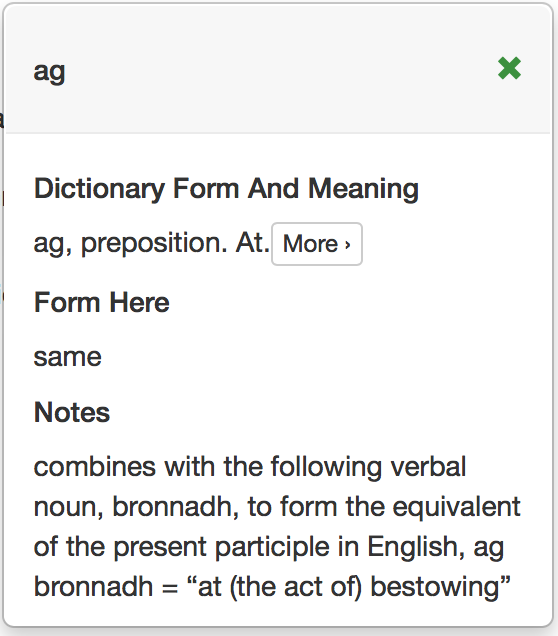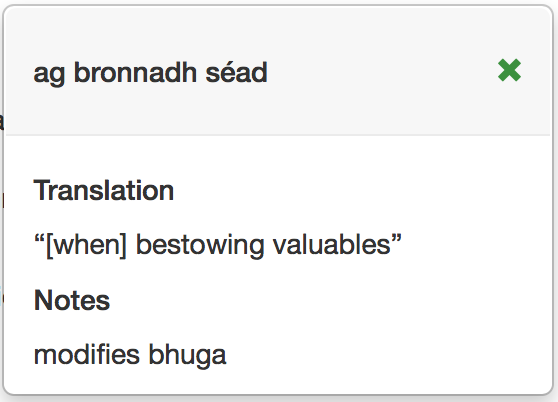Texts
This site’s fundamental feature is a series of excerpts from early modern texts, transcribed and analyzed, found under the “Texts” tab. The collection of excerpts aims to be representative rather than comprehensive, and includes examples across forms and genres so as to accommodate a wide range of reading interests. To that end, selections are drawn from a variety of genres distributed across two overarching categories, “Poetry” and “Prose”:
Excerpts, listed in the “Title” column, are intentionally brief, the goal being for users to move carefully and deliberately through different genres rather than to skim large amounts of material. It is hoped that, in aggregate, close readings of the gathered Texts will help form a body of knowledge and examples with which users can tackle new texts on their own. Under each “Title” are five informational fields (see example from “Brian Ó Ruairc mo rogha leannán,” following):
- “Author” (if known);
- “Léamh team”: those who produced the translations and analysis;
- “Description”: brief identification of genre and period of composition;
- “Manuscript”: link to a manuscript source (if available). (NB: some texts survive in multiple copies; links provided here are primarily to encourage paleographic study and are typically drawn from the Irish Script on Screen database, with kind permission of the Dublin Institute for Advanced Studies.)
We aim for the user to comprehend how the language works in a text, not simply to grasp its general thrust. To that end, there are two, overlapping levels of popovers: one for individual words (accessed by clicking on the red highlight box) and one for larger semantic units/phrases (accessed by clicking the yellow highlight box), for example:
The popover for individual words contains three explanatory fields: “Dictionary Form and Meaning” (how the word would appear in a dictionary), “Form Here” (what form it is taking in the present usage) and “Notes” (explanatory or contextualizing information). Each word is linked to an entry in the “Glossary” via the “More” button. See the example below of the word ag taken from the text “Brian Ó Ruairc mo rogha leannán”:
Knowing that it can be difficult for the newcomer to identify how words work together within a text, the site is designed to identify and analyze individual semantic units and/or phrases. The popover for semantic units contains two explanatory fields, “Translation” and “Notes,” as shown in the example below from “Brian Ó Ruairc, mo rogha leannán”:
Three tabs appear to the right of each Text, “General Guide,” “Detailed Guide” and “Translation”:
General Guide offers pointers for reading that particular genre; Detailed Guide tab offers tips on reading that particular text. For instance, the General Guide accompanying “Brian Ó Ruairc mo rogha leannán” provides pointers for reading bardic poetry, generally, while the Detailed Guide offers assistance deciphering that particular poem. The Translation is intended to be literal, to remain close to the original vocabulary and grammatical character of the selection. More literary renderings, we believe, should be an end goal of users themselves, and the site aims merely to provide the tools with which they might do so.
**New texts will be added at regular intervals, as they are completed.**




